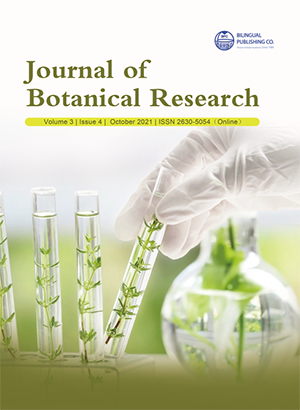-
237
-
198
-
185
-
149
-
138
Storage Mycoflora in Sesame Seed Production in Benue State, Nigeria
DOI:
https://doi.org/10.30564/jbr.v3i4.3482Abstract
Sesame (Sesamum indicum) is usually contaminated with many fungi where some of them are mycotoxigenic causing economic and health problems. This study investigated the percentage composition of fungi contamination of sesame seeds in Benue state Nigeria. Using direct plating technique; the study revealed twelve species of fungi contamination in sesame seed obtained in Benue State. The percentage occurrence of fungal isolates shows that Aspergillus flavus and A. niger were found in all the locations and their occurrence was significantly different (P≤0.05). The percentage contamination of Sesame samples collected from Otukpo LGA has the highest fungal (23.35%) contamination and was significantly higher (P≤0.05) from samples of other places whereas Sesame contamination from Gboko was the least with total percentage of (12.05%). In conclusion, considering the benefits of sesame, it is recommended that several treatments should be applied to reduce the levels of contamination in sesame seeds before consumption utilization such as environmental conditions leading to fungal proliferation (a high temperature, humidity, poor soil fertility, drought and insect damage). Also poor harvesting practices, unsuitable storage conditions, improper transportation, marketing and processing should be discouraged.
Keywords:
Storage fungi; Mycoflora; Storage sesame; Benue stateReferences
[1] Kafiriti, E. and Deckers, J. (2001). Sesame (Sesamum indicum L.). In: R.H. Raemaekers, Crop Production in Tropical Africa (pp.797-804). Brussels, Belgium: Directorate General for Inernational Co-operation.
[2] Reddy, S. (2006) Agronomy of field crops. Kalyani Publishers, New Delhi. pp 50-65.
[3] Gururajan, B., Balasubramanian, R., Swaminathan, V. (2008). Recent Strategies on Crop production. Kalyani Publishers, India. Pp; 20-25.
[4] Balasubramanian, T, and Palaniappal, S. (2011). Sesame. In: P. Rathore (Eds.), Techniques and Management of Field Crops Production. Agriculture and Biological sciences, India. pp. 181-200.
[5] Doko, B. and Enwere, S. (2014). Farmer’s guide for the production and post-harvest handling of sesame products in Nigeria (Training Mannual). STDF Project 172 co-financed by NEPC and STDF, implemented by NEPC and supervised by ITC. PP.10-11.
[6] Jaya, R. (2007). Daily Trust 24 September. Olam Distributes Sesame Seeds to Farmers in Benue, Nasarawa states. P. 12.
[7] Benue State Agricultural and Rural Development Authority [BNARDA], (2011). Benue state Agricultural and Rural development Authority. Annual report pp. 15-30.
[8] Makun H. A., Apeh D. O., Adeyemi H. R. Y., Nagago T., Okeke J. O., Mustapha A. S. and Oyinloye, B. A. (2014). Determination of Aflatoxins in Sesame, Rice, Millet and Acha from Nigeria using HPLC. Chemical Science Transactions, 3(4), 1516-1524.
[9] Varga, J., Frisvad, J.G, Samson, R.A. (2009). A reappraisal of fungi producing aflatoxins. World Mycotoxin Journal. Volume 2: pp263-267.
[10] Ezekiel, C.N. and Sombie J.I. (2014). Survey of Aflatoxins and Fungi in some Commercial Breakfast Cereals and Pastas retailed in Ogun State, Nigeria. Natural Science12 (6):27 – 32.
[11] Jha, D. (1995). Laboratory manual on seed pathology. First edition Vikas publishing house New Delhi, India. pp 7-9.
[12] Davise, H. (2002). Important Fungi. A Guide to Identification. 4th Edition, American Society for Microbiology Press, Washington DC, 1-111.
[13] Klich, M. (2002). Identification of Common Aspergillus Species. Utrech. Central Bureeau Voor Schimmel Cultures. The Netherlands, 116.
[14] Bassem, A., Amal S.H, Ahmed N, Soher E.A, Mohamed G.S. (2016). The prevalence of aflatoxin A. parasiticus in Egyptian sesame seeds. Journal of Chemical Technology. 9 (11) pp 308-319. USA.
[15] Shehu, K. and Bello, M. T. (2011). Effect of environmental factors in the growth of Aspergillus species associated with stored millet grains in Sokoto. Nigerian Journal of Basic and Applied Sciences, 19 (2): 218-223.
[16] Apeh, D. O., Ochai, D. A., Adejumo, A., Muhammed, H. L., Saidu, H. N., Atehnkeng, J., Adeyemi, R. H., Mailafia, S. C. and Makun, H. A. (2016). Mycological concerns with Sorghum, Millet and Sesame in Northern Nigeria. Journal of Analytical and Bio analytical techniques. 7(5).
[17] Mbah, M. C. and Akueshi C. O. (2009). Aflatoxin in Mould Infested Sesame Seeds. African Journal of Biotechnology, 8(3): 391-394. DOI: https://doi.org/10.5897/AJB2009.000-9067.
[18] Makun, H.A., Gbodi, T.A., Tijani, A.S., Abai, A. and Kadir, G.U.( 2007). Toxicological screening of fungi isolated from millet (Pennisetum spp.) during the rainy and dry Harmattan seasons in Niger State, Nigeria. African Journal of Biotechnology.6:34–40.
[19] Diedhiou, P.M., Bandyopadhyay R., Atehnkeng D., Ojionbo P.S. (2011). Aspergillus colonization and aflatoxin contamination of maize and sesame kernels in two agro ecological zones of Senegal. Journal Phytophytology (159):268-275.
[20] Elewaa, S.I., Mostataa M. H., Sahab A.F., Ziedan E. H. (2011) Direct effect of biocontrol agents on wilt and root rot of sesame. Plant protection 44 (5): 493- 504.
[21] Elaigwu, M., Oluma H.O.A, Ochokwunu, D. I. (2017). In vivo and in vitro activities of some Plant extracts on Macrophomina phaseolina (Tassi) Goidthe causal agent of charcoal rot of sesame in Benue State, Nigeria. International Journal of Science and Research Methodology. 5 (4): 23-39.
[22] Amienyo, C.A., Filibus M.G., Oshatuyi, M. (2015) Effect of fungal deterioration on lipid content of sesame seeds (Sesamum indicum). International Journal of phytopathology. PP 2306-1658.
Downloads
How to Cite
Issue
Article Type
License
Copyright © 2021 Author(s)

This is an open access article under the Creative Commons Attribution-NonCommercial 4.0 International (CC BY-NC 4.0) License.




 M. Elaigwu
M. Elaigwu





